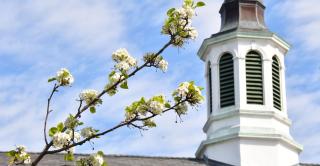
By Leslie Virostek
Pitch pines were once plentiful in the state of Connecticut. But colonial-era commerce and modern-era development have devastated their sandy-soiled habitats. Today, the few pitch pines that remain face a new existential threat: the southern pine beetle or SPB. Will these 3-millimeter-long pests spell the end for the dwindling native tree species? Not if Dr. Alicia Bray can help it.
An entomologist and associate professor of Biology at Central, Bray is an expert in the defense of the remaining pitch, Scotch, and red pines in the state. She does not have an official hotline, but on any given day Bray might receive an urgent call from a stranger asking for her to take a look at property they suspect has been struck by pests. Within a day two, Bray will investigate and collect samples. If it looks like a tree is hosting a colony of SPB, her verdict will be to fell the tree. It’s the best way to prevent a population explosion of the tiny, black beetles that have already killed tens of thousands of trees in the southern United States.
SPB have been advancing up the East Coast during the last five decades and were first detected in Connecticut around 2015. For the past several years Bray and Dr. Claire Rutledge of the Connecticut Agricultural Experiment Station have been coordinating an effort to monitor these invaders in the state. Their team includes scientists from the state Department of Energy and Environmental Protection, the University of New Hampshire, and Western Connecticut State University.
Brays says, like many other tree-infesting beetles, SPB are specialists.
“Different species of trees have their own defense mechanisms to ward off pests,” she said. “It’s impossible for beetles to evade all of them. They adapt to attack particular types of trees.”
When a beetle bores into a pitch pine tree to create its egg galleries, the tree responds by producing sap to flush or “pitch out” the beetles.
“A tree can handle some beetles trying to bore in. But a mass attack can kill a tree,” Bray notes.
Bray’s work includes tracking SPB population metrics in the southern part of the state. (Other team members cover other regions.) Over the summer, she and Central undergraduate Biology major Leanne Bilo set up and monitored traps in Wallingford, Niantic, Groton, and Jewett City. Composed of a series of funnels, one below the other, the traps feature a container of food-grade propylene glycol (which is not toxic to animals) at the bottom. Insects hit the trap, fall, get covered in the slick substance, and cannot escape.
According to Bray, SPB are opportunists who “like stressed trees,” and they are sensitive to the chemical compound emitted by trees weakened by stressors such as drought or disease. The beetles not only target susceptible trees but also emit their own chemical compound — one that summons other beetles to join in the attack. Bray’s traps use the beetle’s own tactics against it. The setup includes attractant lures — pouches that release the compounds emitted by stressed trees, as well as the chemical signals beetles use to invite others. Not far from the trap is a repellent lure that features the “go-elsewhere” compound that beetles use to signal that a tree is at capacity. This serves to steer beetles in the direction of the trap.
After receiving her training from Bray in June, Bilo was tasked with weekly maintenance at the four locations, including collecting the trapped bugs and taking them back to Bray’s lab for counting and identification. The weekly numbers can indicate whether there is a potential outbreak in the making. Bray and her collaborators will also compare the current year's numbers to last year’s to determine if there is a serious uptick in SPB.
But Bray is not just looking to see how many SPB are in the trap. Also significant is the presence of Clerid beetles, predators that may keep the SPB population in check. Bray is exploring whether the ratio of prey to predators can be indicative of whether the SPB population is likely to remain stable or might be on the rise. Working with a predictive model created for the SPB population in the southern U.S., Bray and Rutledge hope to test the model to determine if it is applicable to Connecticut.
Bray became an entomologist because she was fascinated with the creativity and inventiveness employed by insects in their quest to survive and thrive. But she feels compelled to join forces with colleagues and use her expertise to stymie the SPB in Connecticut.
“I love all species, even the southern pine beetle,” she said. “However, it is not native to Connecticut and is hurting a native tree species. These habitats are special and worth preserving for generations to come.”



